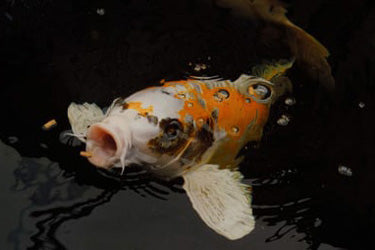Feeding Pond Fish

A Guide to Seasonal Feeding in the UK and similar climates.
There is a huge variety of pond foods available for your pond fish. These include flake for small fish, pellets of various sizes to suit different sizes of fish, and sticks for medium to large fish.

You should choose a reputable brand of pond food that is suitable for the type and size of fish you have, but in temperate climates like the UK, it's also important to consider temperatures in the different seasons so that you can select the correct type of food.
Winter feeding
In the coldest winter months, when temperatures are below 5 degrees C (41 F) or overnight frosts are likely, it is not recommended to feed pond fish at all. This will not do them any harm, as they will be in an almost dormant state at very low temperatures, and feeding can actually be harmful as they will not be able to properly digest any food that they eat. In the UK, this usually means that feeding will cease around late October or November, and re-start around March. However, temperatures will vary year to year of course, so it's a good idea to keep an eye on the weather forecast and use a pond thermometer.
Spring feeding
In springtime when temperatures are beginning to rise, it is best to start feeding with a wheatgerm based food, which is easier for the fish to digest in cooler temperatures, as it normally has a lower protein content and more fibre / roughage. It is usually advised to feed wheatgerm foods when temperatures are still below 10 degrees C (50 F) - but as above, do not feed if overnight frosts are likely. As temperatures increase into double figures (degrees C), you can start to introduce a staple pellet or stick by mixing some in with any remaining wheatgerm you have - it is better to transition the fish between different types of food in this way, rather than abruptly stopping one type and starting a different one.
It is advisable to start slowly with feeding, depending on the interest shown by the fish, so that food is not wasted. In addition, this allows the good bacteria in the filter to build back up after the winter months as the feeding (and hence waste levels) start to increase. This will be especially important in new ponds where the filter is not yet biologically mature.
Summer feeding
Once we are into the warmer summer temperatures and overnight temperatures are remaining in double figures, a combination of staple foods, growth foods and treat foods can be fed. Growth foods contain a higher protein content and will help young fish to grow at their optimum rate and build up their reserves before cooler weather returns. Other higher protein treats such as dried silkworm, mealworm and shrimp can also be fed to add variety.
Autumn feeding
As temperatures begin to fall in the autumn, growth foods should be phased out, transitioning to staple foods and then wheatgerm foods once temperatures start to dip below 10 degrees C. Slowly decrease the amount and / or frequency of feeding, depending on the level of interest shown by the fish. If food remains after several minutes and is being ignored, it should be netted out so that it doesn't break down and affect water quality.
Products
View all
